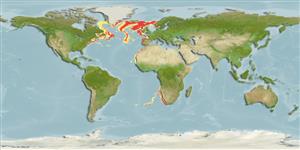Environment: milieu / climate zone / depth range / distribution range
Ökologie
seewasser bathydemersal; tiefenbereich 150 - 2604 m (Ref. 58018). Deep-water; 65°N - 36°S, 77°W - 19°E (Ref. 117245)
Western Atlantic: Davis Strait, off Newfoundland and Middle Atlantic Bight. Eastern Atlantic: Rockall Trough/ Bill Bailey Bank, off Mauritania and off southwestern Africa.
Size / Gewicht / Alter
Maturity: Lm ? range ? - ? cm
Max length : 45.2 cm TL Männchen/unbestimmt; (Ref. 6950)
Kurzbeschreibung
Morphologie | Morphometrie
Rückenflossenweichstrahlen (insgesamt): 15-17. Body uniformly brown with dark fins. Head pores unreduced. Lateral line system with dorsolateral, a mediolateral and a ventral lateral line. Long tail, preanal 33.5-45.9% SL. Body scaled, including neck, fins and abdomen (Ref. 27255). Differs from sympatric species L. vahlii and L. esmarkii by its uniform coloration (vs. bars or marks present), lack of predorsal lateral line, smaller and fewer palatine teeth (3-5 vs. 8-22 and 5-13 respectively) and position of the last precaudal vertebrae in relation to dorsal fin (ray number 15-17 vs.18-19 and 19-20 respectively) (Ref. 36375).
Benthic; feeds on sponge remains, worms, molluscs, pycnogonids, crustaceans and brittle stars (Ref. 58426). Species forgotten in CLOFNAM (10007) and FNAM (4695).
Life cycle and mating behavior
Geschlechtsreife | Fortpflanzung | Ablaichen | Eier | Fecundity | Larven
Anderson, M.E., 1994. Systematics and osteology of the Zoarcidae (Teleostei: Perciformes). Ichthyol. Bull. J.L.B. Smith Inst. Ichthyol. 60:120 p. (Ref. 11954)
IUCN Rote Liste Status (Ref. 130435)
Bedrohung für Menschen
Harmless
Nutzung durch Menschen
Mehr Information
NamenSynonymeMetabolismusRäuberÖkotoxikologieFortpflanzungGeschlechtsreifeAblaichenSpawning aggregationFecundityEierEientwicklung
ReferenzenAquakulturAquakultur ProfilZuchtlinienGenetikElectrophoresesVererbbarkeitKrankheitenVerarbeitungNutrientsMass conversion
PartnerBilderStamps, Coins Misc.LauteCiguateraGeschwindigkeitSchwimmstilKiemenoberflächeOtolithsGehirngrößeSehfähigkeit
Tools
Zusatzinformationen
Download XML
Internet Quellen
Estimates based on models
Preferred temperature (Ref.
123201): 3.1 - 7.1, mean 4.1 °C (based on 329 cells).
Phylogenetic diversity index (Ref.
82804): PD
50 = 0.5000 [Uniqueness, from 0.5 = low to 2.0 = high].
Bayesian length-weight: a=0.00182 (0.00103 - 0.00321), b=3.20 (3.03 - 3.37), in cm total length, based on LWR estimates for this species & (Sub)family-body (Ref.
93245).
Trophic level (Ref.
69278): 3.5 ±0.45 se; based on food items.
Widerstandsfähigkeit (Ref.
120179): sehr niedrig, Verdopplung der Population dauert mehr als 14 Jahre. (Preliminary K or Fecundity.).
Fishing Vulnerability (Ref.
59153): Moderate vulnerability (35 of 100).
